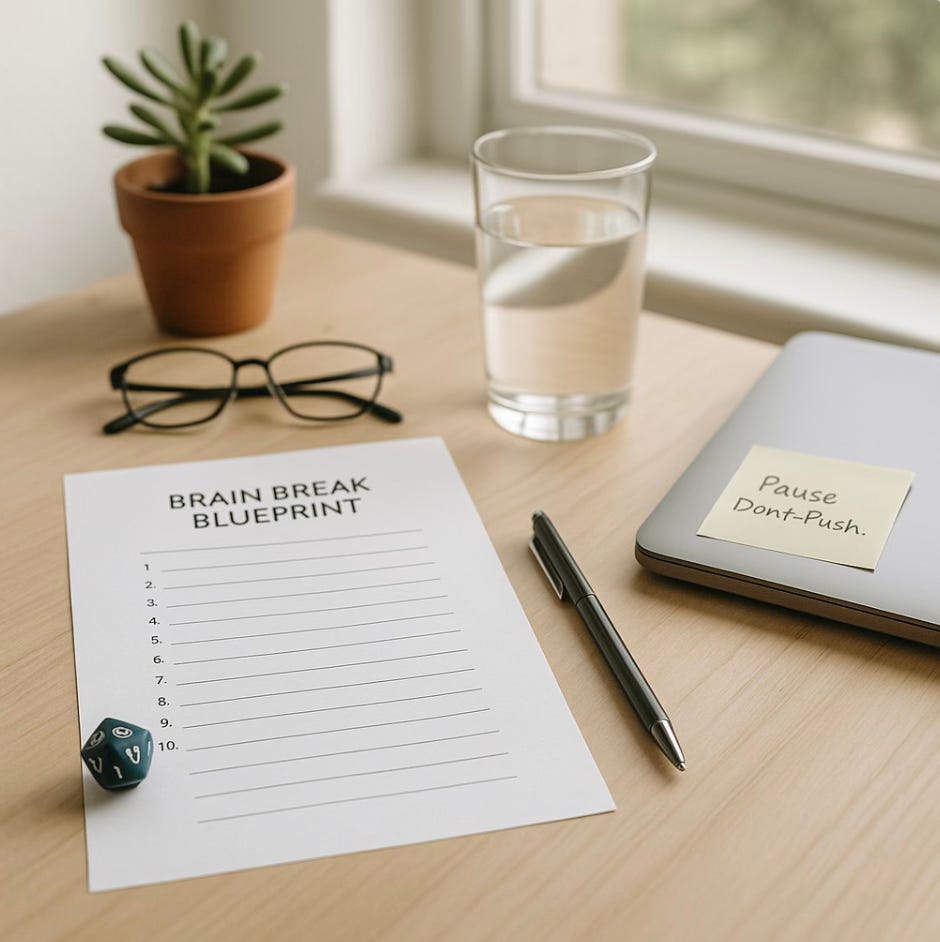The Brain Break Blueprint: How One Reader Built a Micro-Habit System That Actually Works
And why we all need one.
Every week, I write about habits: how they’re built, how they break, and how they quietly shape who we become.
But the best part of this work? Watching readers turn those ideas into action.
Some build reflection rituals. Others start eating fiber first. And some, like Karen Hoffman (a Habit Healers Mindset reader), create entire systems to rewire their automatic responses to stress, fatigue, and the dreaded afternoon slump.
This is the story of how one reader built her own brain break blueprint, a habit loop interrupter powered by a 20-sided dice, and why it might just be the thing your tired brain needs too.
The 20-Sided Antidote to the Snack Spiral
Karen is a writer and editor who spends her days deep in academic work, dense, analytical, high-output thinking. And like many of us, she noticed an unwelcome pattern: when her brain hit that familiar wall of fatigue, she’d unconsciously drift to the kitchen.
Not because she was hungry.
Not because she lacked discipline.
But because her brain was tired and craving a reset.
She tried to name the feeling: was it boredom? frustration? resistance?
None of them quite fit. Until she called it what it was: brain fatigue.
And instead of blaming herself, she did something incredibly smart.
She built a blueprint.
Karen created a list of 20 micro-activities that could serve as true resets—things like stretching on an inversion table, wiping down a bathroom sink, walking the block, or using a muscle gun. Each task was:
active (to reawaken the body),
productive (to calm the nervous system), and
screen-free (to give her cortex breathing room).
Then she grabbed a 20-sided dice.
Whenever she felt that slump, she didn’t open a snack bag or her phone—she rolled the dice. The number told her what to do. No negotiating. No second-guessing. Just honoring the choice and doing the activity.
What she created was more than a distraction. It was a kind, intelligent circuit breaker, a way to meet her brain’s needs without defaulting to food or screens.
Why It Works
We often confuse mental fatigue with hunger. But the real craving is usually for:
Movement
Novelty
A shift in sensory input
A break from cognitive load
Science backs this up:
Mental fatigue impairs impulse control, making snacks and scrolling more tempting.
Physical movement boosts executive function, which restores focus and self-regulation.
Decision fatigue depletes willpower, especially late in the day.
By using a dice, Karen eliminated micro-decisions. That freed up precious mental energy and helped her rewire the loop:
Cue → fatigue → craving → roll the dice → move → reward.
It’s simple. It’s elegant. And it’s profoundly self-respecting.
Want to Build Your Own Brain Break Blueprint?
Here’s how to start:
List 10–20 screen-free, short activities you can do in under 5 minutes.
Choose a mix of energizing and calming actions—bonus points for anything outside or hands-on.
Use a dice (or app, or jar of slips) to let chance decide when you hit a fatigue wall.
Honor the choice. No bargaining. Just shift, move, reset.
And if you want a head start?
I’ve created a printable version of Karen’s system for Inner Circle members, including:
A done-for-you list of brain break actions
A roll tracker to monitor progress
Quick-reflection prompts to help rewire your default habits
A blank template to create your own blueprint
Join The Inner Circle
Inside The Habit Healer’s Mindset Inner Circle, you’ll receive:
Weekly story-led, science-backed habit guides
Printable tools and micro-systems like this one
A supportive rhythm to change not just what you do—but how you live
If you’re tired of trying harder and want to try smarter, this is where we begin.
Click here to join The Inner Circle and download your Brain Break Blueprint.
You’re not broken.
You’re just tired.
Let’s give your brain what it actually needs.







